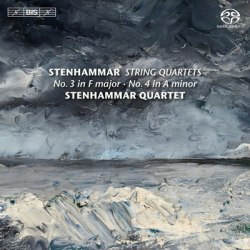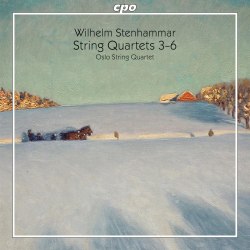|


|
Wilhelm STENHAMMAR (1871-1927)
String Quartet no.4 in A minor, op.25 (1904-09) [33:15]
Lodolezzi Sjunger (Lodolezzi Sings), op.39 (1919) [7:27]
String Quartet no.3 in F, op.18 (1897-1900) [32:13]
Stenhammar Quartet
rec. Petrus Kyrkan, Stocksund, Sweden, June 2012; April and October 2011 (no.4).
BIS BIS-SACD-1659  [73:47] [73:47]
String Quartet no.3 in F, op.18 (1897-1900) [32:53]
String Quartet no.4 in A minor, op.25 (1904-09) [35:30]
String Quartet no.5 in C, op.18 (1897-1900) [20:04]
String Quartet no.6 in D minor, op.25 (1904-09) [25:18]
Oslo Quartet
rec. Jar Kirke, Oslo, 1-4 March 2006 (5 and 6); 8-10 March 2007 (3 and 4).
CPO 777426-2  [68:23 + 45:22]
[68:23 + 45:22]
Wilhelm Stenhammar lived a relatively short life, but still managed
to write seven string quartets. These two recent releases see a Swedish
and a Norwegian quartet in direct competition with each other for
cycle benchmark status. The only other to consider is the sequence
of 1980s AAD recordings available on the Caprice label, still to be
had on the internet (CAP 21337, 21338, 21339). This set consisted
of three different quartets - the Fresk, Copenhagen and Gotland -
who recorded two works each. Rather randomly, Caprice re-spliced these
so that each CD featured two ensembles - with noticeably different
engineering creating a rather needless jar.
Stenhammar has this to say about his quartets, reproduced in the CPO
notes: "…in these Arnold Schönberg times I dream of art
far away from Arnold Schönberg, clear, joyful, and naive". They
are certainly conservative in their conception, both structurally
and harmonically backward-looking. Stenhammar saw himself as following
in the Beethovenian tradition with these works, and this is especially
obvious in the Sixth, which is sullen, reflective, chromatic on the
one hand - a tribute to Stenhammar's late friend Tor Aulin - but elegantly
Haydnesque in parts on the other. Echoes of pure Haydn are most prominent
in the upbeat Fifth, aptly subtitled 'Serenade', whilst the Third
has elements that recall Brahms, even if it is Beethoven whose shadow
again looms large in the closing stages. Masterfully interwoven folk
elements are everywhere too, especially in the Third and the Fourth,
either among the finest quartets ever to have come out of Sweden.
In spite of Stenhammar's own modest aims, there is nothing naive about
any of these exquisitely crafted, highly distinctive and memorable
works.
There are six quartets by traditional numbering, but a seventh, in
F minor dating from 1897 and withdrawn by the composer after its first
performance, appears on volume 2 of the Stenhammar Quartet's survey,
due for release at the time of writing (October 2013). The quartets
from the Third onwards are generally considered Stenhammar's mature
works - perhaps that is why the Oslo Quartet's recording begins there.
The Stenhammar’s volume is definitely the first of three, and
with the inclusion of the F minor will almost certainly be the first
truly complete cycle - and, it must be said, the most authoritative.
BIS also have the better sound, though both Hybrid SACDs knock
the Caprice recordings into a cocked hat. On the other hand, potential
investors into either edition should be aware of both sets of musicians'
breathing habits. Naturally, every performer has the inalienable right
to respire whilst playing, yet there have to be limits. The Stenhammar
first violinist is unaware of any, it seems: like countless others
before him, alas, he leaves almost no soft passage unsnorted. Not
all listeners may notice, and others may notice but not care - perhaps
being inclined to stertor themselves. Yet some at least are sure to
find all the catarrhal melodrama an unattractive distraction from
the music. The Oslo Quartet are in some regards worse: CPO's miking
is more central, which has the advantage of rendering the first violin
less noisy, yet the listener pays by now being able to hear all four
musicians whenever they start hyperventilating. The (cellist's?) panting
at the start of the second movement of the Fifth Quartet, and the
slurping noise at the end of the Sixth, are ludicrously affected.
The fact that many engineers do manage to record quartets without
picking up every inhalation indicates that others, like those of BIS
and CPO, are misplacing microphones. The good news is that on both
CDs there are long stretches where such respiratory shenanigans are
all but inaudible - generally all the louder, vigorous sections.
If CPO do undertake a second volume to give BIS a run for their money,
their producer would do well to discontinue the artificial reverb
at works' ends, a practice that, like extravagant breathing, has no
place in recordings of serious music. In the meantime, the Stenhammar
Quartet, despite their own on-record sniffing, are cruising to the
cycle to have of this underrated composer's anachronistic but actually
rather profound string quartets.
Byzantion
Contact at artmusicreviews.co.uk
Previous review: Jonathan
Woolf
 |
 |
|
